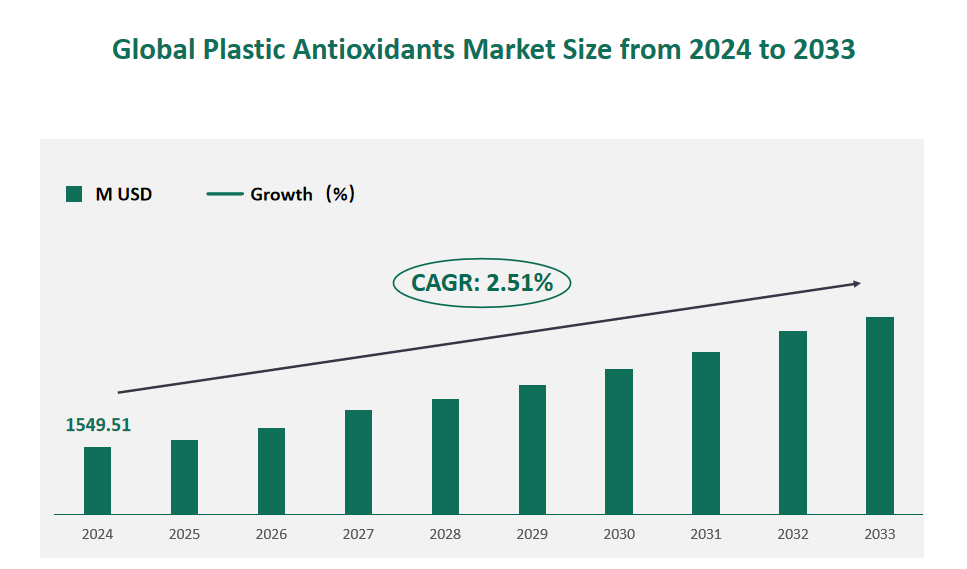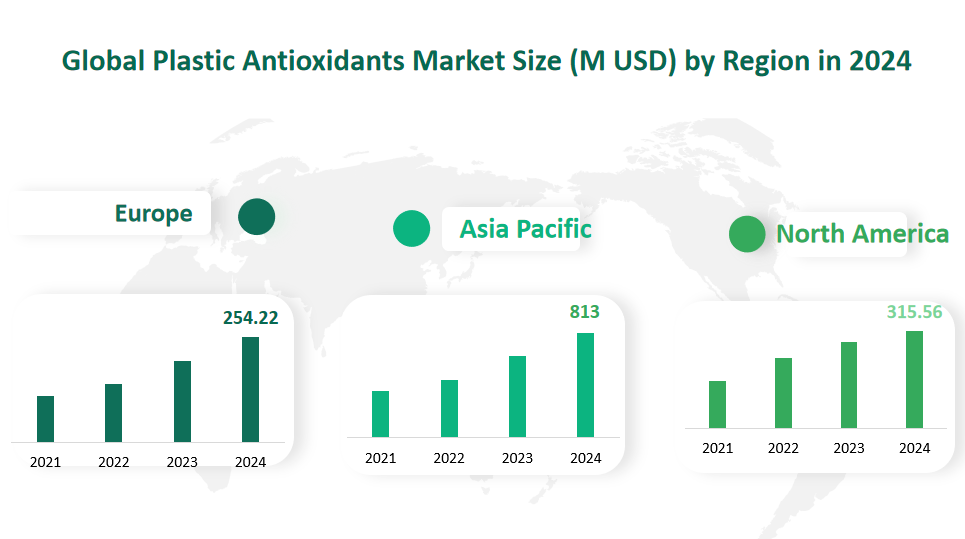1 Global Plastic Antioxidants Market Size (Value) and CAGR (2024-2033)
In 2024, the global Plastic Antioxidants market was valued at USD 1549.51 million, with a CAGR of 2.51% from 2024 to 2033.
Plastic antioxidants are a group of chemicals that slow down the process of oxidation in plastic. Oxidation causes a chemical reaction that produces free radicals—oxygen-containing atoms with an odd number of electrons. Free radicals cause chain reactions that damage the polymer molecules in plastic, degrading their strength and appearance. Antioxidants stop these chain reactions by removing free radicals and inhibit further oxidation by reacting with oxygen to form more stable end products. They are added to plastics during the manufacturing process to reduce the effect of thermal oxidation induced by processing temperatures.
Figure Global Plastic Antioxidants Market Size (M USD) and CAGR 2024-2033

2 Plastic Antioxidants Market Drivers
The growth of the global plastic antioxidants market is driven by several key factors that are shaping the industry’s trajectory. One of the primary drivers is the increasing demand for high-performance plastics across various industries. As the use of plastics in automotive, construction, consumer goods, and electronics sectors continues to expand, the need for effective antioxidants to enhance the durability and stability of these materials becomes more critical. For instance, in the automotive industry, plastic components are increasingly used to reduce vehicle weight and improve fuel efficiency, necessitating the use of antioxidants to ensure these components can withstand prolonged exposure to heat and stress.
Another significant driver is the rapid development and application of new functional plastics. The continuous innovation in plastic materials has led to the creation of high-performance polymers that require advanced stabilization solutions. Plastic antioxidants play a crucial role in this context by protecting against thermal degradation and extending the service life of these materials. This trend is particularly evident in emerging markets, where the demand for advanced plastics is growing rapidly due to industrialization and urbanization.
Government policies and regulations also play a vital role in driving the market. For example, in China, the “Made in China 2025” initiative and the 14th Five-Year Plan have emphasized the development of new materials as a key strategic area. These policies provide a favorable environment for the growth of the plastic antioxidants industry by encouraging technological innovation and investment in the sector. Additionally, the increasing focus on sustainability and environmental protection is driving the development of eco-friendly antioxidants, which are expected to gain more market share in the future.
3 Plastic Antioxidants Market Challenges
Despite the promising growth prospects, the plastic antioxidants market faces several challenges that could impact its development. One of the most significant challenges is the rising cost of raw materials. The production of plastic antioxidants relies heavily on raw materials such as phosphorus trichloride and yellow phosphorus, whose prices have been increasing due to factors like fluctuating international crude oil prices and regional economic and trade policies. For example, the Yunnan provincial government in China issued a decree to limit the rising cost and supply of yellow phosphorus, a key raw material, due to its high energy consumption. This has led to increased production costs for manufacturers, affecting their profitability and competitiveness.
Another major challenge is the environmental and safety concerns associated with the production process. The manufacturing of plastic antioxidants involves the use of flammable and explosive chemical raw materials. If not managed properly, this can lead to environmental pollution and safety accidents, posing risks to both the environment and human health. Additionally, the increasing stringency of environmental regulations and safety standards is forcing manufacturers to invest in advanced technologies and processes to minimize their environmental footprint and ensure compliance.
4 Global Plastic Antioxidants Market Size and Share by Type in 2024
Phenolic antioxidants, also known as primary antioxidants, are highly effective stabilizers that protect plastics from oxidation. They act as free radical scavengers, preventing the formation of peroxides that can degrade polymer chains. These antioxidants are widely used in applications where high thermal stability and long-term protection are required, such as in polyolefins, polyamides, and engineering plastics. In 2024, the market size for phenolic antioxidants is estimated to be 435.35 million USD. This segment is expected to grow steadily due to its essential role in protecting plastics from thermal degradation during processing and service life.
Phosphite and phosphonite antioxidants, often referred to as secondary antioxidants, are used to decompose peroxides formed during the oxidation process. They work synergistically with phenolic antioxidants to provide comprehensive protection against thermal degradation. These antioxidants are particularly effective in maintaining the color and physical properties of plastics during high-temperature processing. In 2024, the market size for phosphite & phosphonite antioxidants is projected to be 571.8 million USD. Their market share is expected to increase as the demand for high-performance plastics continues to grow.
Antioxidant blends are combinations of primary and secondary antioxidants designed to provide optimal stabilization. These blends leverage the strengths of both phenolic and phosphite antioxidants to offer enhanced protection against thermal degradation and oxidation. They are widely used in applications where both processing and long-term stability are critical, such as in automotive and consumer goods industries. In 2024, the market size for antioxidant blends is estimated to be 301.82 million USD. The demand for these blends is driven by the need for versatile and efficient stabilization solutions.
Table Global Plastic Antioxidants Market Size and Share by Type in 2024
Type | Market Size (M USD) 2024 | Market Share 2024 |
Phenolic | 435.35 | 28.10% |
Phosphite & Phosphonite | 571.80 | 36.90% |
Antioxidant Blends | 301.82 | 19.48% |
Others | 240.54 | 15.52% |
5 Global Plastic Antioxidants Market Size and Share by Application in 2024
Thermoplastic plastics are a significant segment within the plastic antioxidants market. These materials include polyethylene (both low-density and high-density), polypropylene, polyvinyl chloride (PVC), and polystyrene. These plastics are widely used in various industries, including packaging, automotive, and consumer goods, due to their flexibility and ease of processing. In 2024, the market size for thermoplastic plastics is estimated to be 1157.06 million USD. The demand for antioxidants in this segment is driven by the need to protect these materials from thermal degradation during processing and service life.
Thermosetting plastics are another critical application area for plastic antioxidants. These materials, such as vulcanized rubber, polyester resin, polyurethane, and epoxy resin, are known for their high strength and resistance to heat and chemicals. Unlike thermoplastics, thermosetting plastics cannot be remolded once they have been cured. This segment is particularly important in industries like automotive, aerospace, and construction, where durability and high-temperature resistance are crucial. In 2024, the market size for thermosetting plastics is projected to be 392.45 million USD. The demand for antioxidants in thermosetting plastics is driven by the need to maintain their physical properties and prevent degradation during processing and long-term use.
Table Global Plastic Antioxidants Market Size and Share by Application in 2024
Application | Market Size (M USD) 2024 | Market Share 2024 |
Thermoplastic Plastics | 1157.06 | 74.67% |
Thermosetting Plastics | 392.45 | 25.33% |
6 Global Plastic Antioxidants Market Size by Region in 2024
The Asia-Pacific region is the largest market for plastic antioxidants, driven by rapid industrialization and urbanization in countries like China and India. The region’s market size in 2024 is estimated to be 813 million USD. The growth in this region is primarily driven by the increasing demand for plastics in automotive, consumer goods, and construction industries. China, in particular, is a major consumer and producer of plastic antioxidants, with significant investments in research and development to enhance product quality and efficiency.
Europe is another significant market for plastic antioxidants, with a market size of 254.22 million USD in 2024. The region’s demand is driven by the automotive and consumer goods industries, which require high-quality plastics with enhanced stability and durability. European countries, such as Germany and Italy, are known for their advanced manufacturing capabilities and stringent quality standards, contributing to the region’s market size.
North America, comprising the United States and Canada, is a key market for plastic antioxidants, with a market size of 315.56 million USD in 2024. The region’s demand is driven by the automotive, construction, and packaging industries. The United States, in particular, is a major consumer of plastic antioxidants, with significant demand from the automotive and consumer goods sectors.
Figure Global Plastic Antioxidants Market Size by Region in 2024

7 Major Players in Global Plastic Antioxidants Market
7.1 BASF SE
Company Profile:
BASF SE is a global leader in the chemical industry, with a diverse portfolio spanning petrochemicals, performance materials, and specialty chemicals. Established in 1865, BASF operates through six business segments: Chemicals, Materials, Industrial Solutions, Surface Technologies, Nutrition & Care, and Agricultural Solutions. The company is headquartered in Germany and has manufacturing facilities across Asia, Europe, North America, and the Middle East. BASF’s product Irganox® 1010 is a widely recognized phenolic antioxidant used in various polymer applications.
Business Overview:
BASF is a multinational chemical company that provides a wide range of products and solutions for various industries, including transportation, energy, construction, consumer goods, electronics, health and nutrition, and agriculture. The company’s extensive product portfolio and global presence enable it to serve a diverse customer base and maintain a strong market position.
Product Overview:
BASF’s Irganox® 1010 is a sterically hindered phenolic primary antioxidant that protects organic substrates such as plastics, synthetic fibers, elastomers, and waxes against thermo-oxidative degradation. It is suitable for a wide range of applications, including polyolefins, polyacetals, polyamides, polyurethanes, polyesters, PVC, and ABS.
Recent Financial Performance:
In 2022, BASF’s revenue in the plastic antioxidants segment was 397.05 million USD, with a gross margin of 34.06%.
7.2 Rianlon
Company Profile:
Rianlon is a leading provider of anti-aging additives and application technologies for polymer materials. Established in 1994, the company is headquartered in China and has a strong presence in Asia, Europe, and the Americas. Rianlon’s product portfolio includes antioxidants (RIANOX), light stabilizers (RIASORB), and customized blending formulations (U-pack). The company is recognized as a “National High-tech Enterprise” in China and is listed on the Chinese stock exchange (stock symbol: 300596).
Business Overview:
Rianlon is committed to providing high-quality anti-aging solutions for polymer materials. The company’s comprehensive product portfolio and strong R&D capabilities enable it to offer tailored solutions to meet the diverse needs of its customers. Rianlon’s focus on innovation and market expansion has helped it establish a strong market position globally.
Product Overview:
Rianlon’s RIANOX® 1010 is a widely used antioxidant suitable for various polymer materials, including general plastics, engineering plastics, rubber, elastomers, coatings, and adhesives. The product is known for its effectiveness in preventing oxidation and maintaining the physical properties of plastics.
Recent Financial Performance:
In 2022, Rianlon’s revenue in the plastic antioxidants segment was 195.84 million USD, with a gross margin of 27.01%.
7.3 Songwon Industrial Co., Ltd.
Company Profile:
Songwon Industrial Co., Ltd. is a global leader in the production of polymer stabilizers and additives. Established in 1965, the company is headquartered in South Korea and has manufacturing facilities in South Korea, China, Germany, the USA, India, and the UAE. Songwon’s product portfolio includes a wide range of antioxidants, coating stabilizers, fuel and lubricant additives, and other specialty chemicals. The company’s SONGXTEND® range of antioxidants is designed to provide high heat stabilization and processing stability for various polymer applications.
Business Overview:
Songwon Industrial Co., Ltd. is a chemical manufacturing company with a diverse product portfolio that serves various industries, including automotive, electronics, and construction. The company’s global presence and strong R&D capabilities enable it to offer innovative solutions and maintain a competitive edge in the market.
Product Overview:
Songwon’s SONGXTEND® range of antioxidants provides high heat stabilization and processing stability for various polymer applications. These antioxidants are designed to protect plastics from thermal degradation and maintain their physical properties during processing and service life.
Recent Financial Performance:
In 2022, Songwon Industrial Co., Ltd.’s revenue in the plastic antioxidants segment was 145.76 million USD, with a gross margin of 30.15%.

